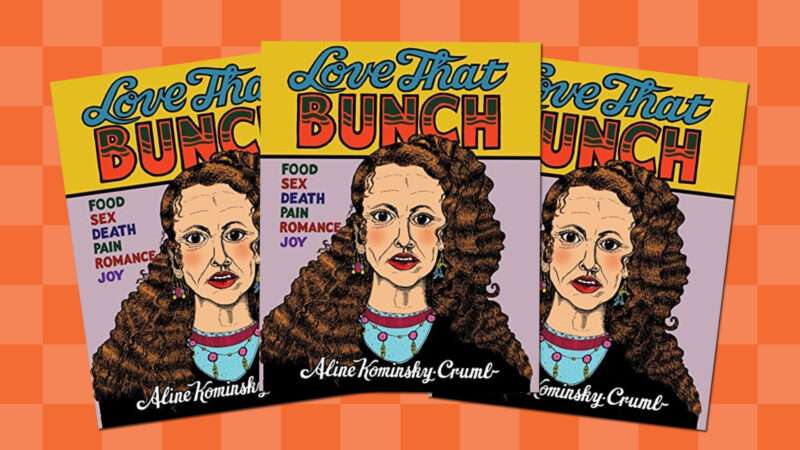
Aline Kominsky-Crumb, a great and trailblazing cartoonist, died this week in her home in France at age 74 from pancreatic cancer.
Kominsky-Crumb grew up in Long Island, and the agonies and complications of her parents’ and family’s “sleaziness, out of control materialism, upward striving, tension, financial problems, selfishness and misery,” as she wrote in her 2007 memoir Need More Love, created a general “post-war jerk family atmosphere” that informed many of her autobiographical comix.
After years of art education in New York and Arizona, she relocated in the early 1970s to San Francisco and began publishing her cartoons in underground comix, influenced by the pioneering autobiographical work of Justin Green. Her 1972 “Goldie: A Neurotic Woman” was the first story in the first issue of one of the first, and longest-lasting, comix periodicals edited and drawn entirely by women, Wimmen’s Comix.
Her story was a brutally honest self-assessment of her relations with family, men, and her own conflicted self-image, with the bare beginnings of her unique lumpy, sweaty, hairy style. Her figuration often seemed like cut-out dolls more than realistic or even conventionally cartoonish humans, influenced more by German expressionists such as George Grosz than any forebear in the world of American comic books, over- or underground. And she was the first to bring this sort of psychologically acute autobiographical approach to comics of any sort.
Underground comix was a realm of small-business entrepreneurialism in the 1970s, very rooted in personal relationships, a strange corner of publishing driven more by the interests of artists than editors or publishers, and distributed through a subterranean, often bordering on criminal, system connected with drug paraphernalia shops (the work itself could be and often was condemned by local officials as illegally obscene). It was thus the perfect, indeed only, space for cartooning voices as conventionally off-putting as Kominsky-Crumb’s to get published and distributed nationally, if not winning huge numbers of fans at first. She broke with the Wimmen’s Comix collective over the individuality of her feminism. She felt that her “sisters” were overly censorious about how she dressed and comported herself.
In a 2021 interview for my book on the history and creators of underground comix, Dirty Pictures, Kominsky-Crumb told me she felt pushed out by “feminist militancy that taken to its most extreme destroys the possibility of enjoying the difference between men and women. Being paid equally, treated with respect of course, I was very much feminist but wanted to create a life exactly as I wanted to, and for me that means having lots of sex partners, being free, and I also wanted to look sexy so I’d attract men….I never felt like a victim. I was choosing who I wanted to be with.” She felt this version of individualist feminism brought censorious wrath on her head from some of her fellow woman cartoonists.
Through the 1970s and ’80s in various comix publications she drew her short, sharp, hilarious tales of mothers and daughters, lovers and husbands, food and body image, being American and being French (having moved to France in the early 1990s), all in a brash, knowing, zesty personal voice. (If you think you can literally “hear” her voice, especially knowing her Long Island Jewish background, you are probably right.) Her—not quite shameless, but certainly brazen—self-revelation through both laughs and tears was the godmother of later generations of pop storytelling showing women’s concerns with themselves and their relationships and sexuality that were knowingly direct and vulgar, such as Lena Dunham with her Girls and Phoebe Waller-Bridge with her Fleabag.
Kominsky-Crumb made great contributions to modern comics as an editor as well, running Weirdo (launched by her husband, cartoonist Robert Crumb, in 1981) from 1986 to 1993. In its pages she was an early promoter of the works of the finest of the post-underground generation of personal female cartoonists, including Carol Tyler, Dori Seda, Krystine Kryttre, Phoebe Gloeckner, and Mary Fleener.
She was a trailblazer, yes, the kind of creator whose cleared paths and innovations were filled and followed by so many after her that the original risks having a modern reader think “you’ve seen and heard it before.” But Kominsky-Crumb was so relentlessly herself, her insights into herself and the world around her so at the same time laced with a deep love and engagement and deep bemused contempt, her twisted, surface-primitive but highly layered and textured panels, linework, and figuration so sui generis that the original never feels superseded by followers.
Kominsky-Crumb enjoyed poormouthing herself, telling stories about how a comic book of hers sold so poorly its publisher used boxes of it for insulation and remembering decades later how hostile Crumb’s fans got about mixing his classical draftsmanship with her “scratchy, ugly drawing” in the couple comix they drew together. But she could still in one conversation with me both say that “I was not in it for money at all, or recognition, which is a good thing because I never got any money or any recognition” and later note with somewhat bemused pride how much of her DNA she sees in modern female storytellers in and out of comics and how she now sees her work “getting academic attention.”
Her innovations in brutally honest memoir and autobiography from a decidedly individualistic feminist perspective mean her work will live, and her storytelling remains one of the best guides one can find to being a torturously free-spirited American woman and semi-popular artist in the second half of the 20th century.
The post Farewell to the Mother of Modern Feminist Cartooning appeared first on Reason.com.
from Latest https://ift.tt/WgAEGhF
via IFTTT